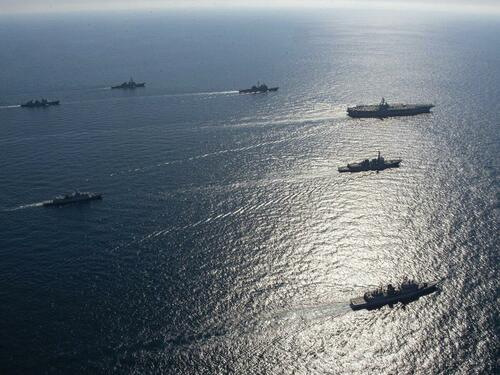
Authored by Kyle Anzalone & Will Porter via The Libertarian Institute,
Washington and Seoul are reportedly discussing plans to ramp up anti-submarine military exercises set to begin next year. The talks came amid soaring tensions in the region, and just days before North Korea pledged to further develop its nuclear arsenal.
While some details of the biannual 'Silent Shark' drills remain undecided, they are set to be "bigger than those of the past, given the North heightening tensions with its dozens of missile tests in recent months," the Korea Times reported last week, citing an unnamed navy official.

Seoul has claimed the exercises are needed to contain the growing threat from Pyongyang, saying they will focus on anti-submarine warfare assets and are "designed to improve their capability to respond to increasing North Korean submarine threats, including its submarine-launched ballistic missiles (SLBMs)."
In October, the DPRK said it had successfully fired a KN-23 SLBM – modeled on the Russian Iskander missile – as part of a flurry of weapon tests carried out in retaliation to joint US-South Korean war games. The nuclear-capable KN-23 was launched from a special underwater reservoir, prompting speculation that Pyongyang may have developed a new launch platform for the weapon.
Military activity on the Korean Peninsula has reached a multi-year high in 2022, with North Korea conducting a record number of missile tests, including two intercontinental ballistic missile (ICBM) launches this month alone. The US and South Korea, for their part, have deployed additional strategic assets to the region, and have carried out several rounds of live-fire military exercises, helping to drive a cycle of escalation with the North.
Earlier this month, Washington flew nuclear-capable, long-range B-1B stealth bombers over Korea during its 'Vigilant Storm' drill as a show of force to Pyongyang. Though US Air Force Chief of Staff CQ Brown Jr. downplayed the maneuvers as "just part of an exercise," the DPRK has repeatedly denounced such drills as provocative, viewing them as preparations for an attack.
In addition to continued missile, rocket and artillery tests, North Korean Supreme Leader Kim Jong-un has pledged to further develop his country’s nuclear capabilities in response to the growing tensions, saying the military would work to improve its nuclear forces at the "fastest possible speed" back in April.
Kim Jong Un is still smoking near fueled liquid propellant ICBMs in 2022. https://t.co/9XbGFWWYMW
— Ankit Panda (@nktpnd) November 18, 2022
More recently, Kim claimed North Korean scientists had made a "wonderful leap forward in the development of the technology of mounting nuclear warheads on ballistic missiles," going on to say that Pyongyang would create "the world’s most powerful strategic force, the absolute force unprecedented in the century."
Authored by Kyle Anzalone & Will Porter via The Libertarian Institute,
Washington and Seoul are reportedly discussing plans to ramp up anti-submarine military exercises set to begin next year. The talks came amid soaring tensions in the region, and just days before North Korea pledged to further develop its nuclear arsenal.
While some details of the biannual ‘Silent Shark’ drills remain undecided, they are set to be “bigger than those of the past, given the North heightening tensions with its dozens of missile tests in recent months,” the Korea Times reported last week, citing an unnamed navy official.

Seoul has claimed the exercises are needed to contain the growing threat from Pyongyang, saying they will focus on anti-submarine warfare assets and are “designed to improve their capability to respond to increasing North Korean submarine threats, including its submarine-launched ballistic missiles (SLBMs).”
In October, the DPRK said it had successfully fired a KN-23 SLBM – modeled on the Russian Iskander missile – as part of a flurry of weapon tests carried out in retaliation to joint US-South Korean war games. The nuclear-capable KN-23 was launched from a special underwater reservoir, prompting speculation that Pyongyang may have developed a new launch platform for the weapon.
Military activity on the Korean Peninsula has reached a multi-year high in 2022, with North Korea conducting a record number of missile tests, including two intercontinental ballistic missile (ICBM) launches this month alone. The US and South Korea, for their part, have deployed additional strategic assets to the region, and have carried out several rounds of live-fire military exercises, helping to drive a cycle of escalation with the North.
Earlier this month, Washington flew nuclear-capable, long-range B-1B stealth bombers over Korea during its ‘Vigilant Storm’ drill as a show of force to Pyongyang. Though US Air Force Chief of Staff CQ Brown Jr. downplayed the maneuvers as “just part of an exercise,” the DPRK has repeatedly denounced such drills as provocative, viewing them as preparations for an attack.
In addition to continued missile, rocket and artillery tests, North Korean Supreme Leader Kim Jong-un has pledged to further develop his country’s nuclear capabilities in response to the growing tensions, saying the military would work to improve its nuclear forces at the “fastest possible speed” back in April.
Kim Jong Un is still smoking near fueled liquid propellant ICBMs in 2022. https://t.co/9XbGFWWYMW
— Ankit Panda (@nktpnd) November 18, 2022
More recently, Kim claimed North Korean scientists had made a “wonderful leap forward in the development of the technology of mounting nuclear warheads on ballistic missiles,” going on to say that Pyongyang would create “the world’s most powerful strategic force, the absolute force unprecedented in the century.”




